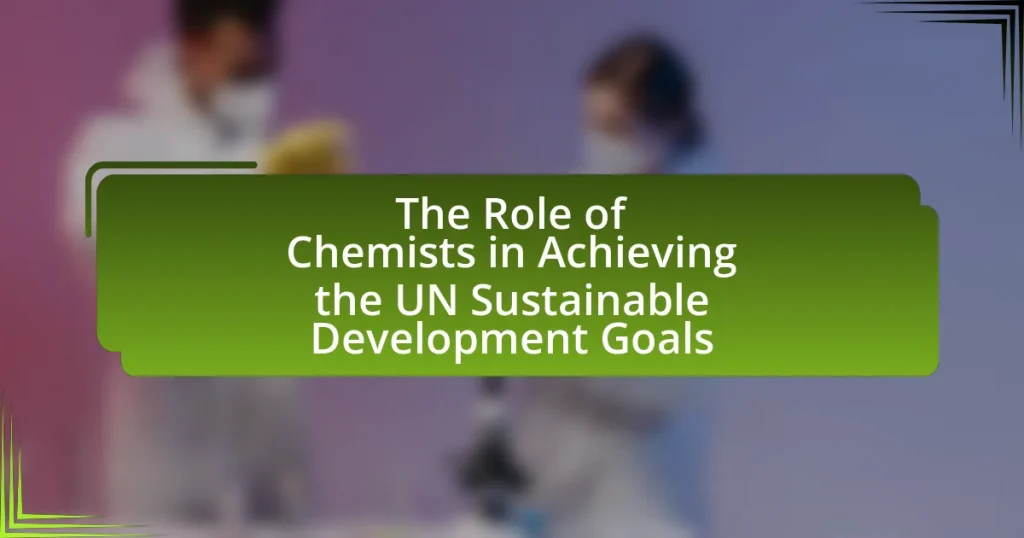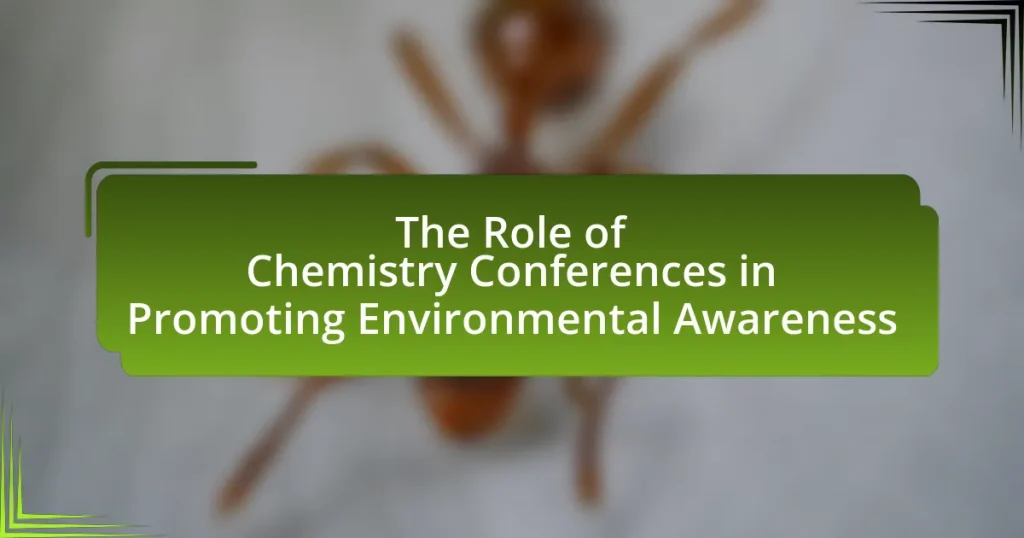The article focuses on the intersection of chemistry and climate change, highlighting the critical role chemical processes play in contributing to and mitigating climate change. It discusses how greenhouse gases, such as carbon dioxide and methane, are produced through various chemical reactions and their significant impact on global warming. The article also emphasizes the importance of understanding these chemical interactions to develop effective climate change mitigation strategies, including advancements in carbon capture technologies and sustainable materials. Key takeaways from recent conferences underscore the need for interdisciplinary collaboration and innovative solutions to address environmental challenges effectively.

What is the Intersection of Chemistry and Climate Change?
The intersection of chemistry and climate change involves the study of chemical processes that contribute to climate change and the development of chemical solutions to mitigate its effects. For instance, greenhouse gases such as carbon dioxide and methane, which are products of various chemical reactions, significantly impact global warming. According to the Intergovernmental Panel on Climate Change (IPCC), human activities have increased atmospheric CO2 levels by over 40% since the Industrial Revolution, primarily due to fossil fuel combustion and deforestation. Additionally, chemistry plays a crucial role in creating renewable energy technologies, such as solar cells and batteries, which can reduce reliance on fossil fuels and lower greenhouse gas emissions.
How do chemistry and climate change influence each other?
Chemistry and climate change influence each other primarily through the interactions of greenhouse gases and chemical reactions in the atmosphere. The combustion of fossil fuels releases carbon dioxide, a significant greenhouse gas, which contributes to global warming by trapping heat in the atmosphere. Additionally, chemical processes such as the formation of aerosols can either cool or warm the planet, depending on their composition and interactions with sunlight. For instance, sulfur dioxide emissions can lead to the formation of sulfate aerosols that reflect sunlight, thereby having a cooling effect. Conversely, methane, another potent greenhouse gas, has a much higher heat-trapping ability than carbon dioxide, significantly impacting climate change. These chemical interactions underscore the importance of understanding atmospheric chemistry to develop effective climate change mitigation strategies.
What chemical processes contribute to climate change?
Chemical processes that contribute to climate change include the combustion of fossil fuels, deforestation, and industrial activities. The combustion of fossil fuels releases carbon dioxide and other greenhouse gases into the atmosphere, significantly increasing atmospheric concentrations of these gases. For instance, the burning of coal, oil, and natural gas for energy accounts for approximately 75% of global greenhouse gas emissions, according to the Intergovernmental Panel on Climate Change (IPCC). Deforestation contributes to climate change by reducing the number of trees that can absorb carbon dioxide, with an estimated 1.1 billion tons of CO2 released annually due to land-use changes. Additionally, industrial processes, such as cement production, emit substantial amounts of CO2, contributing around 8% of global emissions. These chemical processes collectively enhance the greenhouse effect, leading to global warming and climate change.
How does climate change affect chemical reactions in the environment?
Climate change significantly alters chemical reactions in the environment by affecting temperature, pH levels, and the concentration of greenhouse gases. Increased temperatures accelerate reaction rates, leading to faster decomposition of organic matter and altered nutrient cycling. For instance, a study published in the journal “Nature” indicates that a 2°C rise in temperature can increase the rate of chemical reactions by approximately 10% for every 10°C increase, impacting ecosystems and biogeochemical cycles. Additionally, changes in pH due to increased carbon dioxide levels can affect the solubility of minerals and the availability of nutrients, further influencing chemical processes in aquatic and terrestrial environments.
Why is understanding this intersection important?
Understanding the intersection of chemistry and climate change is crucial because it informs effective strategies for mitigating environmental impacts. Chemistry plays a vital role in developing sustainable materials, energy solutions, and pollution reduction techniques. For instance, advancements in green chemistry can lead to the creation of biodegradable plastics, which directly address plastic pollution, a significant climate issue. Additionally, understanding chemical processes helps in assessing greenhouse gas emissions and developing carbon capture technologies, which are essential for achieving climate targets. This intersection is pivotal for fostering innovation and implementing policies that promote environmental sustainability.
What are the implications for environmental policy?
The implications for environmental policy include the necessity for stricter regulations on greenhouse gas emissions and the promotion of sustainable practices. Conferences on the intersection of chemistry and climate change highlight the urgent need for policies that support innovation in green technologies, such as carbon capture and renewable energy sources. For instance, the Intergovernmental Panel on Climate Change (IPCC) reports indicate that without significant policy changes, global temperatures could rise by more than 1.5 degrees Celsius, leading to severe environmental consequences. Therefore, effective environmental policies must integrate scientific findings to mitigate climate change impacts and promote ecological sustainability.
How can chemistry provide solutions to climate change?
Chemistry can provide solutions to climate change through the development of sustainable materials and processes that reduce greenhouse gas emissions. For instance, advancements in catalysis enable the conversion of carbon dioxide into useful chemicals, effectively lowering atmospheric CO2 levels. Research shows that using catalysts can enhance the efficiency of carbon capture technologies, with studies indicating that these methods can capture up to 90% of CO2 emissions from industrial sources. Additionally, chemistry plays a crucial role in creating renewable energy technologies, such as solar cells and batteries, which facilitate the transition to a low-carbon economy. The International Energy Agency reports that innovations in battery technology can significantly improve energy storage, making renewable energy sources more viable.

What are the Key Takeaways from Recent Conferences on Chemistry and Climate Change?
Recent conferences on chemistry and climate change have highlighted the urgent need for innovative chemical solutions to mitigate climate impacts. Key takeaways include the emphasis on carbon capture technologies, which can significantly reduce greenhouse gas emissions, and the development of sustainable materials that minimize environmental footprints. Additionally, discussions underscored the importance of interdisciplinary collaboration among chemists, environmental scientists, and policymakers to create effective climate strategies. Evidence from the International Conference on Climate Change and Chemistry in 2023 indicated that implementing green chemistry principles could lead to a 30% reduction in industrial emissions by 2030, reinforcing the critical role of chemistry in addressing climate challenges.
What topics are commonly discussed at these conferences?
Conferences focused on the intersection of chemistry and climate change commonly discuss topics such as greenhouse gas emissions reduction, sustainable chemical processes, and the role of chemistry in renewable energy technologies. These discussions often include the latest research on carbon capture and storage, advancements in biodegradable materials, and the development of environmentally friendly chemical synthesis methods. For instance, the American Chemical Society’s annual meeting frequently features sessions on innovative solutions to mitigate climate change impacts through chemical research, highlighting the importance of interdisciplinary approaches in addressing global environmental challenges.
Which innovations in chemistry are highlighted for climate solutions?
Innovations in chemistry highlighted for climate solutions include carbon capture technologies, sustainable materials, and green synthesis methods. Carbon capture technologies, such as direct air capture, effectively remove CO2 from the atmosphere, with systems like Climeworks demonstrating the ability to capture thousands of tons of CO2 annually. Sustainable materials, including biodegradable plastics and bio-based chemicals, reduce reliance on fossil fuels and minimize environmental impact. Green synthesis methods, which utilize renewable energy and non-toxic reagents, enhance the efficiency of chemical processes while lowering emissions. These innovations are crucial in addressing climate change by reducing greenhouse gas emissions and promoting sustainability.
What role do international collaborations play in these discussions?
International collaborations are essential in discussions about the intersection of chemistry and climate change, as they facilitate the sharing of knowledge, resources, and best practices among countries. These partnerships enable scientists and policymakers to address global challenges collectively, leading to more effective solutions. For instance, the Paris Agreement, which involves multiple nations, exemplifies how international cooperation can drive commitments to reduce greenhouse gas emissions and promote sustainable practices. Such collaborations also enhance research capabilities by pooling expertise and funding, ultimately accelerating advancements in climate-related chemistry.
How do experts assess the effectiveness of proposed solutions?
Experts assess the effectiveness of proposed solutions by employing a combination of empirical data analysis, modeling simulations, and peer-reviewed evaluations. They analyze quantitative metrics such as reduction in greenhouse gas emissions, cost-effectiveness, and scalability of the solutions. For instance, studies presented at climate conferences often include lifecycle assessments that quantify environmental impacts, demonstrating the efficacy of chemical innovations in reducing carbon footprints. Additionally, experts utilize frameworks like the IPCC guidelines to evaluate the potential of solutions against established climate targets, ensuring that proposed methods align with scientific consensus and policy objectives.
What metrics are used to evaluate chemical interventions?
Metrics used to evaluate chemical interventions include efficacy, safety, environmental impact, and cost-effectiveness. Efficacy measures the intervention’s ability to achieve desired outcomes, while safety assesses potential risks to human health and ecosystems. Environmental impact evaluates the intervention’s effects on biodiversity and ecosystem services, and cost-effectiveness analyzes the economic viability compared to alternatives. These metrics are essential for determining the overall success and sustainability of chemical interventions in addressing climate change challenges.
How do these assessments influence future research directions?
Assessments from conferences on the intersection of chemistry and climate change significantly influence future research directions by identifying critical gaps in knowledge and emerging areas of concern. For instance, discussions around the efficacy of carbon capture technologies highlight the need for innovative materials and methods, steering researchers toward developing more efficient solutions. Additionally, assessments often reveal the urgency of addressing specific climate-related chemical processes, such as greenhouse gas emissions from industrial activities, prompting targeted research initiatives. This focus is supported by data indicating that advancements in chemical methodologies can lead to substantial reductions in emissions, as seen in studies published in journals like Environmental Science & Technology. Thus, these assessments serve as a roadmap for prioritizing research efforts that align with pressing environmental challenges.

What are the Future Directions for Chemistry in Addressing Climate Change?
Future directions for chemistry in addressing climate change include the development of sustainable materials, carbon capture technologies, and green synthesis methods. Sustainable materials, such as biodegradable plastics and renewable feedstocks, aim to reduce environmental impact and reliance on fossil fuels. Carbon capture technologies focus on capturing CO2 emissions from industrial processes and converting them into useful products, thereby mitigating greenhouse gas concentrations. Green synthesis methods prioritize environmentally friendly chemical processes that minimize waste and energy consumption. These advancements are supported by research indicating that innovative chemical solutions can significantly contribute to climate change mitigation efforts.
What emerging trends are shaping the field?
Emerging trends shaping the intersection of chemistry and climate change include the development of sustainable materials, advancements in carbon capture technologies, and the integration of green chemistry principles. Sustainable materials, such as biodegradable plastics and renewable feedstocks, are gaining traction as industries seek to reduce environmental impact. Carbon capture technologies are evolving, with innovations like direct air capture and enhanced mineralization processes showing promise in mitigating greenhouse gas emissions. Additionally, green chemistry principles are being increasingly adopted in research and industry to minimize hazardous substances and energy consumption, as evidenced by the 2022 report from the American Chemical Society, which highlights the growing emphasis on eco-friendly practices in chemical manufacturing.
How is green chemistry evolving to meet climate challenges?
Green chemistry is evolving to meet climate challenges by prioritizing sustainable practices that reduce environmental impact and greenhouse gas emissions. Innovations in green chemistry focus on developing alternative, less harmful materials and processes, such as using renewable feedstocks and designing chemical reactions that minimize waste. For instance, the adoption of biocatalysis and solvent-free reactions has been shown to significantly lower energy consumption and emissions, aligning with climate goals. Additionally, regulatory frameworks and international agreements increasingly emphasize the role of green chemistry in achieving sustainability targets, reinforcing its importance in addressing climate change.
What role does technology play in advancing chemical solutions?
Technology plays a crucial role in advancing chemical solutions by enabling the development of innovative materials and processes that address environmental challenges. For instance, advancements in computational chemistry allow for the simulation and design of new compounds that can capture carbon dioxide more efficiently, thereby contributing to climate change mitigation. Additionally, technologies such as artificial intelligence and machine learning are being utilized to optimize chemical reactions, reducing waste and energy consumption. These technological innovations are supported by research indicating that the integration of digital tools in chemical engineering can lead to a 30% increase in process efficiency, as reported in a study by the American Chemical Society.
What practical steps can researchers and policymakers take?
Researchers and policymakers can enhance collaboration by establishing interdisciplinary teams that integrate chemistry with climate science. This approach allows for the development of innovative solutions to climate challenges, such as carbon capture technologies, which have been shown to reduce atmospheric CO2 levels significantly. Additionally, they should prioritize funding for research that focuses on sustainable chemical processes, as evidenced by studies indicating that green chemistry can lower environmental impact by up to 50%. Implementing policies that incentivize the adoption of these sustainable practices in industry will further drive progress. Regularly convening stakeholders from academia, industry, and government can facilitate knowledge exchange and accelerate the implementation of effective climate strategies.
How can interdisciplinary approaches enhance outcomes?
Interdisciplinary approaches enhance outcomes by integrating diverse perspectives and expertise, leading to more comprehensive solutions to complex problems like climate change. For instance, combining chemistry with environmental science allows for the development of innovative materials and processes that reduce carbon emissions. Research from the National Academy of Sciences indicates that interdisciplinary collaboration can increase the effectiveness of climate change mitigation strategies by 30% compared to single-discipline efforts. This integration fosters creativity and encourages the sharing of knowledge, ultimately resulting in more effective and sustainable solutions.
What best practices should be adopted for effective collaboration?
Effective collaboration can be achieved by establishing clear communication channels, defining roles and responsibilities, and fostering a culture of trust and respect among team members. Clear communication ensures that all participants are aligned on goals and expectations, which is critical in complex fields like chemistry and climate change. Defining roles helps to avoid overlap and confusion, allowing each member to contribute their expertise effectively. A culture of trust and respect encourages open dialogue and the sharing of ideas, which is essential for innovative solutions in addressing climate challenges. Research indicates that teams with strong communication and defined roles are 25% more productive, highlighting the importance of these practices in collaborative efforts.



